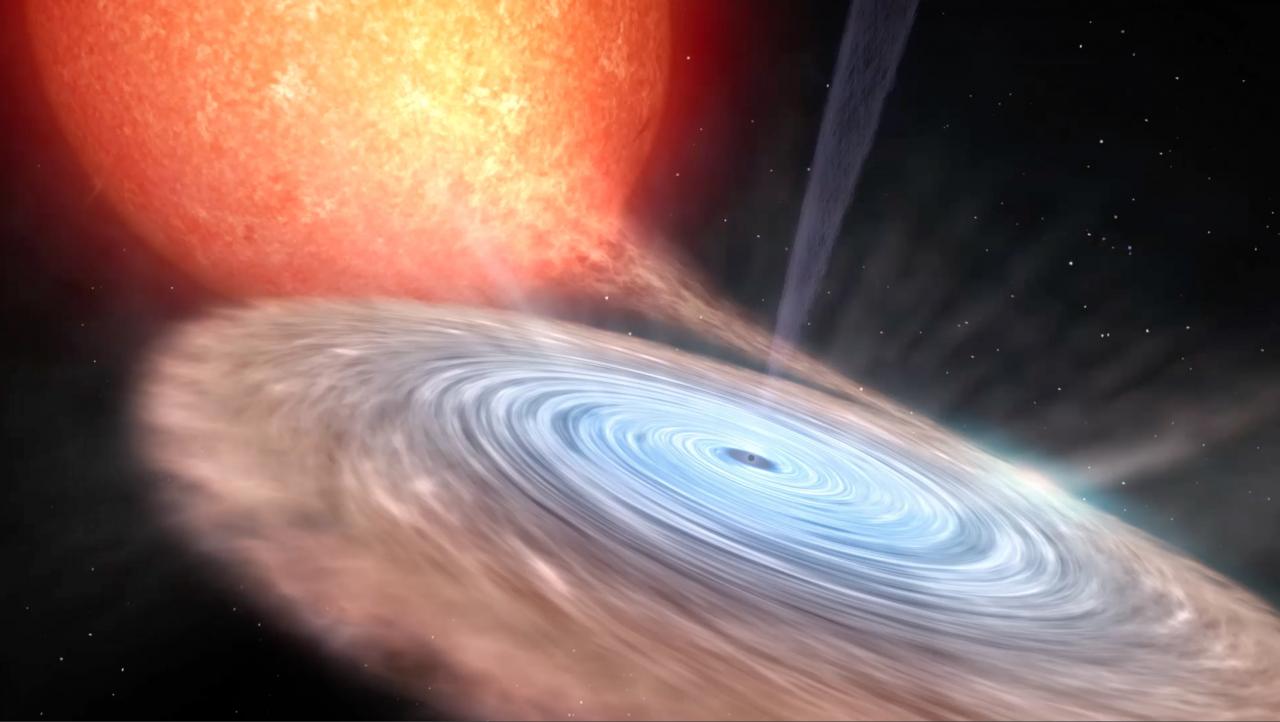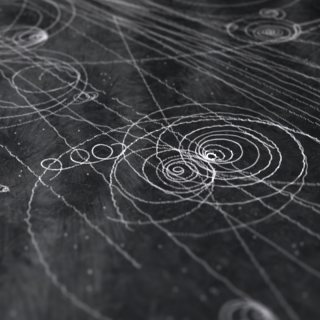Subvenciones relacionadas:
General
Los agujeros negros y estrellas de neutrones en binarias de rayos-X son laboratorios únicos para explorar la física de estos objetos compactos. No solo permiten confirmar la existencia de agujeros negros de origen estelar a través de mediciones dinámicas de sus masas, sino que también permiten investigar el comportamiento de la materia y la radiación bajo la influencia de un campo gravitatorio extremo. De este modo, es posible estudiar la física del proceso de acreción, la forma más eficiente de producción de energía conocida. El conocimiento de este proceso es esencial para entender el Universo, jugando un papel crucial en la astronomía galáctica y extra-galáctica.
Los objetivos científicos que se persiguen son:
- Estudios de acreción y eyección. Esta línea explota una fenomenología que nuestro grupo ha descubierto recientemente y se enfoca en la relación universal existente entre el proceso de acreción en agujeros negros y los procesos de expulsión en forma de jets colimados y vientos. Se pondrá énfasis en las propiedades generales y el efecto que el viento frío que hemos descubierto en binarias de rayos-X tiene sobre todo el proceso de acreción. Investigaremos como de comunes son estos vientos, como afectan al proceso de acrecimiento en el agujero negro y cuál es su relación con los jets y los vientos observados en rayos-X. Asimismo se realizarán estudios espectrales detallados en rayos X, con el fin de caracterizar los diferentes estados y geometrías de acreción en función de la luminosidad.
- Tenemos como objetivo definir la distribución de masas de agujeros negros estelares y estrellas de neutrones. Para ello medimos masas en binarias de rayos-X, continuando así nuestra ya reconocida contribución a uno de los experimentos fundamentales en la astrofísica moderna. De este modo, esperamos mejorar significativamente las distribuciones conocidas de objetos compactos, lo cual permitirá verificar modelos de explosión de supernovas y evolución de binarias compactas; además de obtener límites a la ecuación de estado de la materia nuclear. Para ello, mediremos las masas en binarias de rayos-X conocidas o recientemente descubiertas, e intentaremos encontrar un gran número de nuevas binarias de rayos X en nuestra galaxia que puedan después ser estudiadas dinámicamente.
- Analizar la estructura y variabilidad de los discos de acreción alrededor de los objetos compactos en diferentes bandas espectrales (óptico-rayos X). La distribución espectral durante la erupción (especialmente a altas energías) y su variación temporal es esencial para restringir los modelos de erupción y la estructura física del disco (e.g. radio del disco advectivo) así como la contribución del jet a la emisión en el visible y el infrarrojo.
Miembros
Resultados
- Nuestro equipo ha liderado un ambicioso estudio multi-frecuencia que cubrió las dos erupciones de 2015 del agujero negro transitorio V404 Cyg. Este evento ha sido uno de los más interesantes jamás observados de este tipo. En 2018 publicamos el trabajo global que recoge todos los datos espectroscópicos tomados en 1989 y 2015.
- Presentamos la evidencia de viento similar al detectado en V404 Cyg en un segundo sistema con agujero negro, V4641 Sgr.
- Se publicó tanto el artículo final como un estudio piloto sobre el método desarrollado por el grupo para descubrir y medir masas en agujeros negros en quietud. Esta técnica, potencialmente, podría triplicar la población conocida de estos objetos.
- Se medió la masa de la estrella de neutrones en PSR J2215+5135, una de las más masivas que se conocen hasta la fecha.
- Se presentó el primer estudio detallado del sistema ultra-compacto SLX 1737-282.
Actividad científica
Publicaciones relacionadas
-
Follow-up Survey for the Binary Black Hole Merger GW200224_222234 Using Subaru/HSC and GTC/OSIRIS
The LIGO/Virgo detected a gravitational wave (GW) event, named GW200224_222234 (also known as S200224ca) and classified as a binary-black hole coalescence, on 2020 February 24. Given its relatively small localization skymap (71 deg 2 for a 90% credible region; revised to 50 deg 2 in GWTC-3), we performed target-of-opportunity observations using the
Ohgami, Takayuki et al.Fecha de publicación:
42023 -
A shared accretion instability for black holes and neutron stars
Accretion disks around compact objects are expected to enter an unstable phase at high luminosity 1. One instability may occur when the radiation pressure generated by accretion modifies the disk viscosity, resulting in the cyclic depletion and refilling of the inner disk on short timescales 2. Such a scenario, however, has only been quantitatively
Vincentelli, F. M. et al.Fecha de publicación:
32023 -
Precision Ephemerides for Gravitational-wave Searches - IV. Corrected and refined ephemeris for Scorpius X-1
Low-mass X-ray binaries have long been theorized as potential sources of continuous gravitational-wave radiation, yet there is no observational evidence from recent LIGO/Virgo observing runs. Even for the theoretically 'loudest' source, Sco X-1, the upper limit on gravitational-wave strain has been pushed ever lower. Such searches require precise
Killestein, T. L. et al.Fecha de publicación:
42023 -
A black widow population dissection through HiPERCAM multiband light-curve modelling
Black widows are extreme millisecond pulsar binaries where the pulsar wind ablates their low-mass companion stars. In the optical range, their light curves vary periodically due to the high irradiation and tidal distortion of the companion, which allows us to infer the binary parameters. We present simultaneous multiband observations obtained with
Mata Sánchez, D. et al.Fecha de publicación:
42023 -
Systematic uncertainties in the characterization of helium-dominated metal-polluted white dwarf atmospheres
White dwarf photospheric parameters are usually obtained by means of spectroscopic or photometric analysis. These results are not always consistent with each other, with the published values often including just the statistical uncertainties. The differences are more dramatic for white dwarfs with helium-dominated photospheres, so to obtain
Izquierdo, Paula et al.Fecha de publicación:
42023 -
A rapid optical and X-ray timing study of the neutron star X-ray binary Swift J1858.6-0814
We present a rapid timing analysis of optical (HiPERCAM and ULTRACAM) and X-ray (NICER) observations of the X-ray transient Swift J1858.6-0814 during 2018 and 2019. The optical light curves show relatively slow, large amplitude (~1 mag in g s) 'blue' flares (i.e. stronger at shorter wavelengths) on time-scales of ~minutes as well as fast, small
Shahbaz, T. et al.Fecha de publicación:
32023 -
The TRAPUM L-band survey for pulsars in Fermi-LAT gamma-ray sources
More than 100 millisecond pulsars (MSPs) have been discovered in radio observations of gamma-ray sources detected by the Fermi Large Area Telescope (LAT), but hundreds of pulsar-like sources remain unidentified. Here, we present the first results from the targeted survey of Fermi-LAT sources being performed by the Transients and Pulsars with
Clark, C. J. et al.Fecha de publicación:
32023 -
Deep X-Ray and Radio Observations of the First Outburst of the Young Magnetar Swift J1818.0-1607
Swift J1818.0-1607 is a radio-loud magnetar with a spin period of 1.36 s and a dipolar magnetic field strength of B ~ 3 × 10 14 G, which is very young compared to the Galactic pulsar population. We report here on the long-term X-ray monitoring campaign of this young magnetar using XMM-Newton, NuSTAR, and Swift from the activation of its first
Ibrahim, A. Y. et al.Fecha de publicación:
12023 -
First detection of the outer edge of an AGN accretion disc: very fast multiband optical variability of NGC 4395 with GTC/HiPERCAM and LT/IO:O
We present fast (~200 s sampling) $\it ugriz$ photometry of the low -mass AGN NGC 4395 with the Liverpool Telescope, followed by very fast (3 s sampling) u s, g s, r s, i s, and z s simultaneous monitoring with HiPERCAM on the 10.4m GTC. These observations provide the fastest ever AGN multiband photometry and very precise lag measurements. Unlike
McHardy, I. M. et al.Fecha de publicación:
32023 -
Two decades of optical timing of the shortest-period binary star system HM Cancri
The shortest-period binary star system known to date, RX J0806.3+1527 (HM Cancri), has now been observed in the optical for more than two decades. Although it is thought to be a double degenerate binary undergoing mass transfer, an early surprise was that its orbital frequency, f 0, is currently increasing as the result of gravitational wave
Munday, James et al.Fecha de publicación:
22023 -
Self-supervised clustering on image-subtracted data with deep-embedded self-organizing map
Developing an effective automatic classifier to separate genuine sources from artifacts is essential for transient follow-ups in wide-field optical surveys. The identification of transient detections from the subtraction artifacts after the image differencing process is a key step in such classifiers, known as real-bogus classification problem. We
Mong, Y. -L. et al.Fecha de publicación:
12023 -
A dense 0.1-solar-mass star in a 51-minute-orbital-period eclipsing binary
Of more than a thousand known cataclysmic variables (CVs), where a white dwarf is accreting from a hydrogen-rich star, only a dozen have orbital periods below 75 minutes 1-9. One way to achieve these short periods requires the donor star to have undergone substantial nuclear evolution before interacting with the white dwarf 10-14, and it is
Burdge, Kevin B. et al.Fecha de publicación:
102022 -
Black hole mass and spin measurements through the relativistic precession model: XTE J1859+226
The X-ray light curves of accreting black holes and neutron stars in binary systems show various types of quasi-periodic oscillations (QPOs), the origin of which is still debated. The relativistic precession model identifies the QPO frequencies with fundamental time-scales from General Relativity, and has been proposed as a possible explanation of
Motta, S. E. et al.Fecha de publicación:
112022 -
A refined dynamical mass for the black hole in the X-ray transient XTE J1859+226
We present two contiguous nights of simultaneous time-resolved Gran Telescopio Canarias spectroscopy and William Herschel Telescope photometry of the black hole X-ray transient XTE J1859+226, obtained in 2017 July during quiescence. Cross-correlation of the individual spectra against a late K-type spectral template enabled us to constrain the
Yanes-Rizo, I. V. et al.Fecha de publicación:
112022 -
Long-term photometric monitoring and spectroscopy of the white dwarf pulsar AR Scorpii
AR Scorpii (AR Sco) is the only radio-pulsing white dwarf known to date. It shows a broad-band spectrum extending from radio to X-rays whose luminosity cannot be explained by thermal emission from the system components alone, and is instead explained through synchrotron emission powered by the spin-down of the white dwarf. We analysed NTT/ULTRACAM
Pelisoli, Ingrid et al.Fecha de publicación:
112022 -
Multicolour optical light curves of the companion star to the millisecond pulsar PSR J2051-0827
We present simultaneous, multicolour optical light curves of the companion star to the black-widow pulsar PSR J2051-0827, obtained approximately 10 yr apart using ULTRACAM and HiPERCAM, respectively. The ULTRACAM light curves confirm the previously reported asymmetry in which the leading hemisphere of the companion star appears to be brighter than
Dhillon, V. S. et al.Fecha de publicación:
102022 -
A correlation between H α trough depth and inclination in quiescent X-ray transients: evidence for a low-mass black hole in GRO J0422+32
We present a new method to derive binary inclinations in quiescent black hole (BH) X-ray transients (XRTs), based on the depth of the trough (T) from double-peaked H α emission profiles arising in accretion discs. We find that the inclination angle (i) is linearly correlated with T in phase-averaged spectra with sufficient orbital coverage (≳50 per
Casares, J. et al.Fecha de publicación:
102022 -
Simultaneous X-ray and optical spectroscopy of V404 Cygni supports the multi-phase nature of X-ray binary accretion disc winds
Observational signatures of accretion disc winds have been found in a significant number of low-mass X-ray binaries at either X-ray or optical wavelengths. The 2015 outburst of the black hole transient V404 Cygni provided a unique opportunity for studying both types of outflows in the same system. We used contemporaneous X-ray (Chandra Observatory)
Muñoz-Darias, Teo et al.Fecha de publicación:
82022 -
Discovery of optical and infrared accretion disc wind signatures in the black hole candidate MAXI J1348-630
MAXI J1348-630 is a low mass X-ray binary discovered in 2019 during a bright outburst. During this event, the system experienced both hard and soft states following the standard evolution. We present multi-epoch optical and near-infrared spectroscopy obtained with X-shooter at the Very Large Telescope. Our dataset includes spectra taken during the
Panizo-Espinar, G. et al.Fecha de publicación:
82022 -
A Multiwavelength Study of GRS 1716-249 in Outburst: Constraints on Its System Parameters
We present a detailed study of the evolution of the Galactic black hole transient GRS 1716-249 during its 2016-2017 outburst at optical (Las Cumbres Observatory), mid-infrared (Very Large Telescope), near-infrared (Rapid Eye Mount telescope), and ultraviolet (the Neil Gehrels Swift Observatory Ultraviolet/Optical Telescope) wavelengths, along with
Saikia, Payaswini et al.Fecha de publicación:
62022



